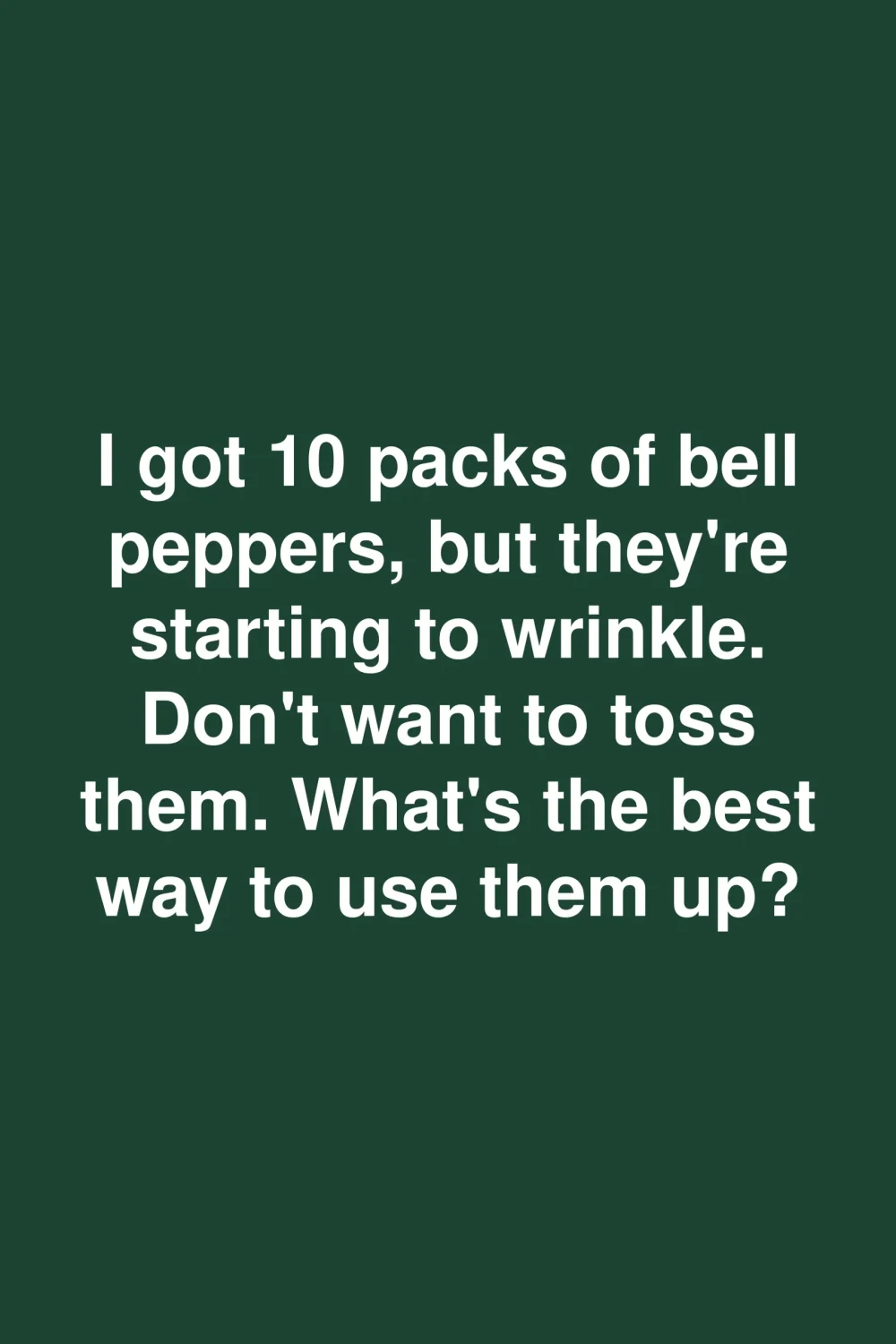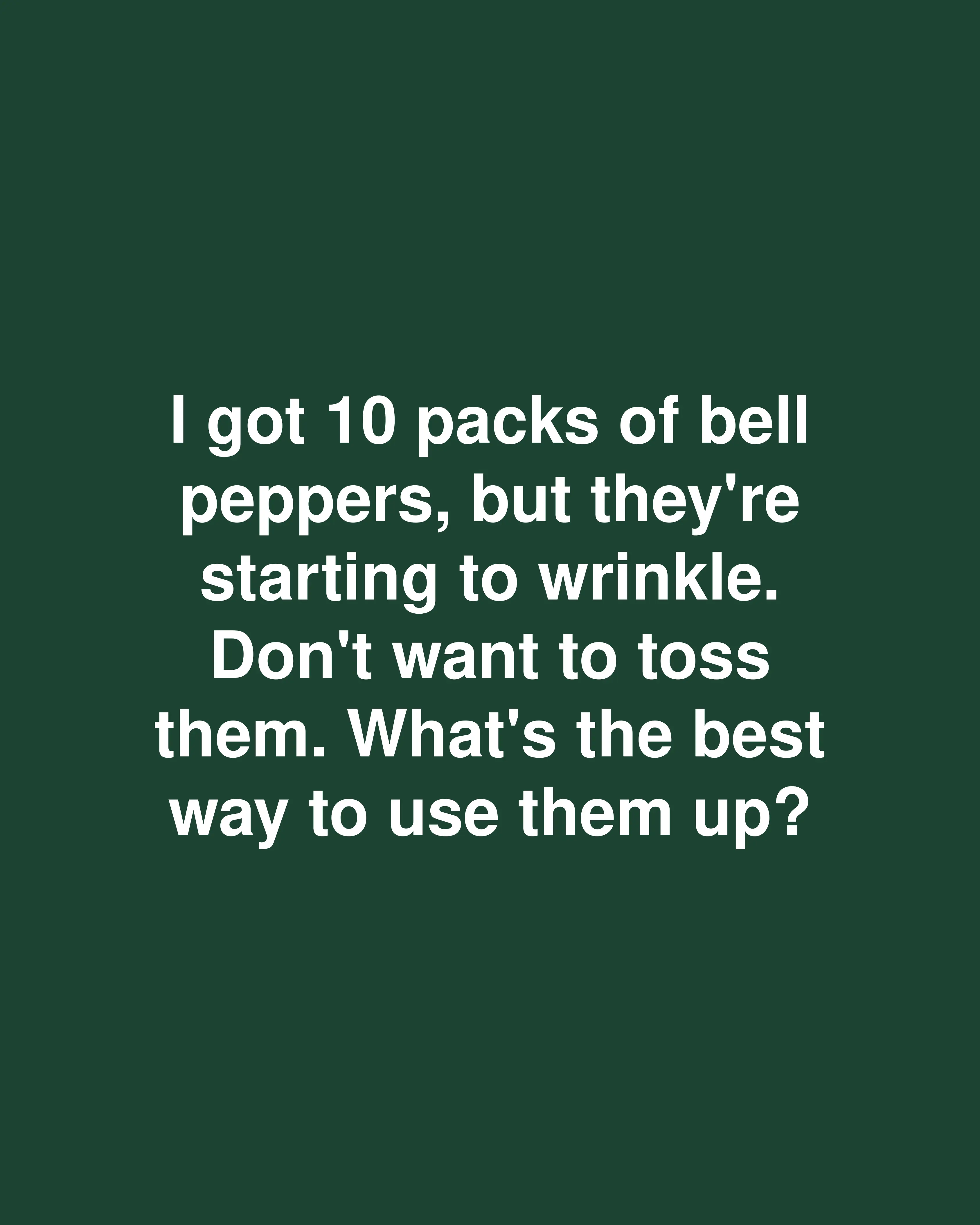Want to save this recipe?
Enter your email below and we’ll send the recipe straight to your inbox!
10 Creative Ways to Save Bell Peppers Before They Spoil
We’ve all been there. You spot a beautiful array of colorful bell peppers at the grocery store and fill your cart with grand culinary ambitions. Fast forward a week later, and those once-vibrant peppers are starting to wrinkle in your refrigerator drawer, silently reproaching you for your neglect. Before you resign yourself to tossing them in the trash, take heart! Those peppers still have plenty of delicious potential.
Why Bell Peppers Deserve a Second Chance
Bell peppers aren’t just pretty faces in your produce drawer—they’re nutritional powerhouses packed with vitamins A and C. They bring vibrant color, sweet crunch, and versatile flavor to countless dishes. The red, yellow, orange, and green varieties each offer slightly different flavor profiles, from the sweetness of red peppers to the grassier notes of green ones.
When peppers begin to soften, they’re actually at their sweetest. While they might not be ideal for a fresh salad at this stage, they’re perfect for cooking methods that bring out their natural sugars and intensify their flavors.
Top 10 Ways to Use Up Bell Peppers Before They Go Bad
1. Classic Stuffed Peppers
Stuffed peppers are perhaps the most iconic way to use bell peppers, and slightly softened ones work beautifully. Cut off the tops, remove the seeds and membranes, and fill with a mixture of cooked rice, browned ground meat (or plant-based alternative), tomato sauce, and cheese.
For a quick variation, try a Mediterranean stuffing with couscous, feta, olives, and herbs. Or go Mexican-inspired with black beans, corn, and taco seasoning. Bake until the peppers are tender and the filling is heated through—usually about 30-35 minutes at 375°F.
2. Quick Pepper Stir-Fry
Transform your peppers into a speedy weeknight dinner by slicing them into strips for a colorful stir-fry. Heat some oil in a wok or large skillet over high heat, add your pepper strips along with other quick-cooking vegetables like snap peas or broccoli, and your protein of choice.
A simple sauce of soy sauce, garlic, ginger, and a touch of honey brings everything together. The entire dish comes together in under 15 minutes, perfect for busy evenings when you need dinner on the table fast.
3. Roasted Red Pepper Soup
Turn those peppers into a velvety, comforting soup that freezes beautifully. Roast the peppers until their skins blacken and blister, then steam them in a covered bowl to loosen the skins. Peel away the charred exterior and blend the flesh with sautéed onions, garlic, vegetable broth, and a splash of cream.
The result is a luxurious soup with complex, smoky-sweet flavors that belies its simple ingredients. Serve with crusty bread for a light but satisfying meal.
4. Breakfast Pepper-and-Egg Scramble
Dice those peppers finely and sauté them until soft, then add beaten eggs for a nutritious breakfast scramble that comes together in minutes. The natural sweetness of the peppers pairs perfectly with the richness of eggs.
For an elevated version, add a sprinkle of feta cheese and fresh herbs just before serving. This protein-packed breakfast will keep you energized through the morning without weighing you down.
5. Homemade Pepper Salsa
Transform peppers into a vibrant salsa that will elevate tacos, grilled chicken, or simple tortilla chips. Dice the peppers finely and combine with chopped tomatoes, red onion, cilantro, lime juice, and jalapeño for heat.
The resulting salsa is far fresher than store-bought versions, with bright flavors that wake up any dish it accompanies. Plus, it keeps in the refrigerator for several days, giving your peppers a new lease on life.
6. Grilled Pepper Skewers
Fire up the grill (or grill pan) and thread chunks of bell pepper onto skewers, alternating with other vegetables like zucchini, mushrooms, and cherry tomatoes. Brush with olive oil, sprinkle with salt and herbs, and grill until lightly charred.
These colorful vegetable skewers make a beautiful side dish for summer cookouts or a light vegetarian main when served over rice or quinoa. The high heat of grilling caramelizes the natural sugars in the peppers, intensifying their sweetness.
7. Pizza Night Peppers
Thinly sliced bell peppers make a perfect pizza topping, adding color, flavor, and nutrition to your homemade pies. For the best results, sauté the pepper slices briefly before adding them to your pizza—this ensures they’ll be tender rather than watery when the pizza is done.
Try a combination of different colored peppers for visual appeal, and pair them with complementary toppings like Italian sausage, mushrooms, or olives.
8. Colorful Pasta Primavera
Create a vibrant pasta primavera by sautéing sliced bell peppers with garlic, onions, and other spring vegetables. Toss with al dente pasta, a splash of pasta cooking water, good olive oil, and freshly grated Parmesan cheese.
This simple pasta dish lets the natural flavors of the vegetables shine and comes together in about the time it takes to boil the pasta. It’s a perfect solution for those nights when you need a quick but satisfying meal.
9. Quick-Pickled Peppers
Extend the life of your peppers by pickling them. Slice the peppers and pack them into clean jars. Bring a mixture of vinegar, water, sugar, salt, and spices to a boil, then pour over the peppers. Seal the jars and refrigerate.
These quick-pickled peppers will last for weeks in your refrigerator and add bright, tangy flavor to sandwiches, salads, and charcuterie boards. They’re particularly delicious on an Italian sub or chopped into a pasta salad.
10. Fajita Feast
Slice those peppers into strips and whip up a sizzling platter of fajitas. Sauté the pepper strips with sliced onions until they’re soft and slightly caramelized, then add your protein of choice—traditional options include skirt steak or chicken breast, but shrimp or portobello mushrooms work beautifully too.
Serve with warm tortillas and all the fixings: guacamole, sour cream, salsa, and lime wedges. This interactive meal is perfect for family dinners or casual entertaining.
Common Mistakes When Using Bell Peppers
Avoid these common pitfalls to get the most from your peppers:
- Not removing the bitter white pith and seeds: Take the extra minute to clean out the interior completely.
- Undercooking or overcooking: Bell peppers can be enjoyed with a slight crunch or fully softened—but rubbery, half-cooked peppers aren’t appealing.
- Forgetting to roast: Roasting intensifies the natural sweetness of peppers. Don’t miss this opportunity for flavor development.
- Using the wrong colored pepper: Green peppers are less sweet and more pungent than their red, yellow, and orange counterparts. Choose the right color for your dish.
Extra Benefits Beyond Flavor
Rescuing your bell peppers isn’t just about creating delicious meals—it’s also:
- Budget-friendly: Reducing food waste directly impacts your grocery budget.
- Nutritionally smart: Bell peppers are rich in antioxidants, vitamins C and A, and fiber.
- Environmentally responsible: Food waste in landfills produces methane, a potent greenhouse gas.
- Culinary skill-building: Learning to use ingredients at different stages of ripeness makes you a more versatile cook.
Quick Recap: Giving Bell Peppers a Second Life
Those slightly wrinkled bell peppers in your crisper drawer aren’t a lost cause—they’re an opportunity to create something delicious. From classic stuffed peppers to quick stir-fries, soups, and salsas, there are countless ways to transform these versatile vegetables into flavorful meals.
The next time you notice your peppers starting to soften, don’t reach for the trash can. Instead, reach for one of these recipes and turn potential food waste into a culinary triumph. Your wallet, your taste buds, and the planet will all thank you.
Frequently Asked Questions
How can I tell if a bell pepper is too far gone to use?
While wrinkled skin and slight softening are fine for cooking, avoid peppers with moldy spots, slimy texture, or an off smell. Some discoloration is normal as peppers age, but black or dark spots often indicate spoilage.
Can I freeze bell peppers for later use?
Absolutely! Slice or dice clean bell peppers, spread them on a baking sheet to freeze individually, then transfer to freezer bags. They’ll keep for up to 8 months and are perfect for cooked dishes (though not for raw applications).
Are colored bell peppers nutritionally different from green ones?
Yes! Red, orange, and yellow bell peppers are simply more mature versions of green peppers. As they ripen, they develop more vitamin C, vitamin A, and antioxidants—plus a sweeter flavor. Green peppers have a slightly more bitter, grassy taste.
What’s the best way to store bell peppers to extend their life?
Store whole bell peppers in the vegetable crisper drawer of your refrigerator, where they’ll keep for about a week. Don’t wash them until you’re ready to use them, as moisture accelerates spoilage.


